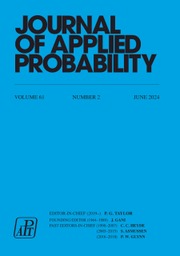No CrossRef data available.
Article contents
The algebraic equivalence of two measures of genetic distance
Published online by Cambridge University Press: 14 July 2016
Abstract
A formal proof is given of the equivalence, conjectured by Rostron, of two measures of the genetic difference between two populations.
Keywords
- Type
- Short Communications
- Information
- Copyright
- Copyright © Applied Probability Trust
Footnotes
∗
Present address: CSIRO Division of Mathematics and Statistics, P.O. Box 218, Lindfield NSW 2070, Australia.
References
Rostron, J. (1978) Genetic colonizing distance and a problem in algebra (abstract). Adv. App. Prob. 11, 7–8.Google Scholar
Cameron, R. and Martin, W. (1944) The Wiener measure of Hilbert neighborhoods in the space of real continuous functions. J. Math. Phys. 23, 195–209.Google Scholar
Lipster, R. and Shiryayev, A. (1977) Statistics of Random Processes, I (General Theory) and II (Applications). Springer-Verlag, New York.Google Scholar
Myers, L., Paulson, D., Berry, W., Cox, E., Laszlo, J. and Stanley, W. (1980) A time-dependent statistical model which relates current clinical status to prognosis: application to advanced prostatic cancer. J. Chronic Diseases 33, 491–499.Google Scholar
Prentice, R. and Kalbfleisch, J. (1979) Hazard rate models with covariates. Biometrics 35, 25–39.Google Scholar
Woodbury, M. and Manton, K. (1977) A random walk model of human mortality and aging. Theoret. Popn. Biol. 11, 37–48.Google Scholar
Woodbury, M., Manton, K. and Stallard, E. (1979) Longitudinal analysis of the dynamics and risk of coronary heart disease in the Framingham study. Biometrics 35, 575–585.Google Scholar


